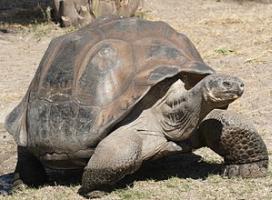 For the first time in 150 years, baby giant tortoises have been born on the Galapagos island of Pinzón. Biologists reported that they had observed ten tiny, newly hatched saddleback tortoises on the island early last month. They commented that there may be many more because their size and camouflage makes them hard to spot. The discovery indicates that the giant tortoise is once again able to reproduce on its own in the wild.
For the first time in 150 years, baby giant tortoises have been born on the Galapagos island of Pinzón. Biologists reported that they had observed ten tiny, newly hatched saddleback tortoises on the island early last month. They commented that there may be many more because their size and camouflage makes them hard to spot. The discovery indicates that the giant tortoise is once again able to reproduce on its own in the wild.
In the 1600s, there were an estimated 250,000 giant tortoises on the islands of the Galapagos archipelago. Indeed, around 1535, Bishop Tomás de Berlanga christened the islands, Galapagos, an archaic Spanish word for turtle or tortoise. By the 1970s, the number had dropped to only around 3,000, accompanied by predictions of the extinction of the tortoises which had given the islands their name.
The Galapagos islands are relatively isolated, straddling the equator, about 500 miles from the coast of South America in the Pacific Ocean. Their isolation resulted in a large number of endemic species, which Charles Darwin studied during the second voyage of HMS Beagle. When he visited the islands in 1835, there were 15 distinct species of tortoise on the various islands of the Galapagos. Only 10 species survive today.
The islands themselves are relatively arid, generally without good supplies of water or wood. They were however close to the sperm whaling grounds. Whalers passing by were attracted by the tortoises as a supply of fresh meat. A 450 pound Galapagos giant tortoise could live for a year lashed to the deck of a whaling ship, without food or water. Between 1784 and 1860, whalers took more than 100,000 tortoises from the islands. Several species of tortoise on various islands became extinct.
Almost worse than the tortoises the whalers carried off were what they left behind. Rats, goats, and cats preyed on the eggs and hatchlings of tortoise and birds. When the predation by whalers ended, the rats, in particular, continued to eat eggs and attack young tortoises. When the Charles Darwin Research Station Center and other environmental groups began an aggressive tortoise hatching program, they had to raise the young tortoises for several years before returning them to their respective islands, so that they were large enough to defend themselves against the rats. Unless the rats could be eradicated, any tortoises hatched on the islands would be at serious risk.
In 2012, the Galapagos National Park launched Project Pinzón, an ambitious initiative to rid Pinzón island of rats once and for all. The plan: to helicopter in 40 tons of poisoned rat bait and disperse it around the island. The poison was specifically designed to target rodents without killing birds or other wildlife on the island. By December of 2012, the island was declared rat free. Efforts are now underway to eradicate the rodents on larger islands in the archipelago.
From a low of around 3,000, the tortoise hatching programs have increased the number of tortoises on the islands to close to 20,000. If the success of hatching baby tortoises on Pinzón island can be replicated on the other islands in the Galapagos, the giant tortoises may once again have a sustainable future.
